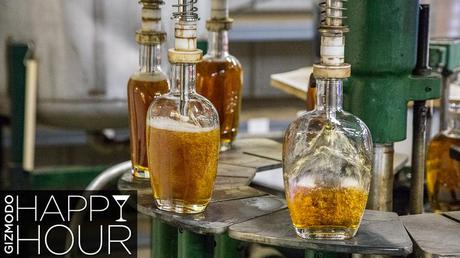
Regular readers know that I’m a huge Gizmodo fan. I ingest their spiel daily like a Phoenix House graduate loving him the sights and sounds of Tompkins Square Park on a mid-Summer early morning. All of Gawker’s assets post frequently and have just about the highest quality content of any blog known to yours truly. I suspect Giz’s scribes – in particular – have a penchant for “lubricating” their minds on the regular due to the stratosphericlly far-reaching research/writing demands “bestowed” on them by their Gawker editorial mother-ship. Based on the frequency with which the divigate into articles on… uh… imbibery (containing just enough science to pass technology blog muster – nice ruse guys) I theorize that I’m not far off base. Take Brent Rose’s latest booze-themed post on America’s spirit claim-to-fame: Bourbon.
The good alcoholics folks at Gawker were recently schooled on all things Bourbon by none other than historic distiller Four Roses down in Good Ol’ Boy Lawrenceburg Can-tuck-EEE. Preferring Bakers, Makers, and Woodford Reserve myself, I’ve unfortunately never tried Four Roses personally. You can bet, that after reading this intriguing article, that will soon change. I’m a sucker for mystique, obscurity, and uniqueness and this article definitely stoked my artistic and thirsty fires. To wit, Giz teases us:
Now look… if you were unedumacated about Bourbon before, blindly ordering and sipping whatever variety of swill ye olde neighborhood hot-spot happened to have, I’m about to drop some very basic knowledge on your ass. Like Cognac and Champagne are to those snooty bastards that bastion of all good things cheese and wine, France; Bourbon, is a purely American invention. In fact, there are effectively four actual legal requirements set by the Fed in Title 27: Alcohol, Tobacco and Firearms for a Whiskey to be sold as Bourbon. They happen to be:
- Produced within the confines of the United States
- Produced from 51% (or greater) corn Mash Bill (Rye, Wheat and Barley are other common grains used for Mash, the starting mix)
- Aged in only new charred White-Oak barrels
- Distilled to no greater than 160 proof but bottled at no less than 80 proof (some liquid typically evaporates from barrels [known as "Angel's Share"] leaving greater concentrations)
Notice, I didn’t say American “product.” Reason being: there are plenty of other countries producing notable (and conversely shiteous) corn whiskey using similar – if not identical – processes (save for that nagging Made in U.S.A. bit). Within the U.S., however, it can’t be called “Bourbon” if these rules aren’t strictly adhered to.
That, dear readers, is a great segway into that all-to-popular, and commonly misunderstood, brown licka known as Jack Daniels “Tennessee Whiskey.” Have you ever wondered why they just don’t call it Bourbon? Or, do you lose sleep (or cringe) when run-of-the-mill waiters and bartenders rattle it off in the same category as Jim Beam, Makers Mark, Knob Creek, Bulleit, etc.? I fall into the later group simply because frankly, I’m an asshole purist. The common misunderstanding is that Jack Daniels is differentiated from “other” Bourbons (yeesh!) due to their re-use of Sour Mash in a pay-it-forward kind of fashion for the next batch of Whiskey. Well, that’s not exactly accurate. Whiskey distillers of all walks of life re-use a bit of Sour Mash a practice not exception. The primary reason, I suspect, is that it contributes to overall product consistency from batch to batch.
Jack Daniels cannot legally call itself Bourbon because they have a habit of filtering their hooch through Sugar Maple Charcoal prior to aging. Several other distilleries either filter or steep their Whiskies using Charcoal as well. Either way, it’s commonly referred to as the “Lincoln County Process,” and cannot be labeled “Bourbon” on these here shores. As for the rest of the world? They’re clearly not bound by U.S. law and can slap a label on their bottles, calling them whatever the hell they damn well please.
Anyway, for a fairly detailed explanation of the exact process, without boring you to tears – reading War & Peace, head on over to Giz for the wonderfully well-written full article.

